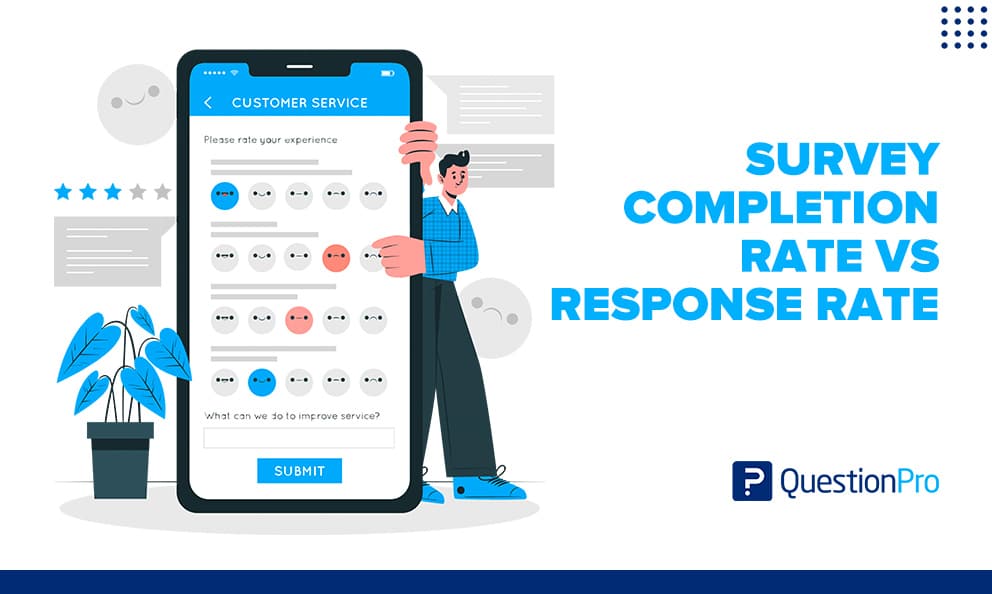 Reading Time: 4 minutes read
Reading Time: 4 minutes readIf you’ve ever been involved in online polls or surveys, you’ve probably been familiar with terms like “completion rate” and “response rate.” To use the words correctly, you must know their meanings and differences. By being aware of the concepts, you can improve your survey’s sample rate and statistical efficiency.
Higher response and completion rates mean better survey results. Here, we’ll explain what the two terms indicate and how they’re connected but different in surveys. So, let’s find out.
What is the survey completion rate?
The survey completion rate is the percentage of survey participants who finish the survey. It is the number of people who have completed an online survey divided by the number of survey respondents who started.
Only respondents who entered your survey and finished it would be included in this statistic. Someone who started but didn’t finish the survey won’t boost your completion rate.
Survey completion rate calculation
The formula for the completion rate is shown below:
Let’s calculate the completion rate using the below-listed survey data.
- 1000 emails have been sent.
- 500 people started the survey.
- 400 people completed the survey.
Completion Rate = (Number of completed surveys / Number of respondents that started the survey) x 100
Completion Rate = (400/450) x 100 = 0.8 x 100 = 80%
The completion rate depends on the users who have at least started your survey. In this situation, the survey’s reach is ignored.
Low completion rate
Low completion rates indicate that respondents dislike your survey. The following are a few potential causes for this:
- Poorly framed questions
If the questions are hard to understand, people are less likely to fill out the survey. The question may be hard to understand because of how it is written or the words used.
For instance, what shift do you usually work, and when do you eat?
This question is badly phrased because it asks about shift and snack time at once. It’s preferable to ask two inquiries separately than together.
- Long Survey
A lengthy survey can lower completion rates. The average length is ten questions, and each question should be no more than two lines. It is crucial to avoid making your survey unnecessarily long and asking an excessive number of questions. This may cause respondents to become uninterested and cause them to drop out of your survey.
- Misleading questions
It’s important not to ask questions that could mislead the person answering, so try not to ask these kinds of questions.
For instance, instead of asking, “How high is the Eiffel Tower?” it’s better to say, “What do you think of the Eiffel Tower’s height?”
- Target audience
People only fill out the survey if they think it is necessary and up to their standards. So, it’s essential to choose the right group of people to reach.
Asking people over 60 about a smartphone brand’s performance isn’t always wise. Younger target groups are more appropriate in this situation.
What is the survey response rate?
The response rate can be defined as the percentage of those who were asked to participate in a survey to those who actually finished the survey. It is the number of people who have completed an online survey divided by the number of people to whom the survey has been sent. It looks a lot like the completion rate, but it is not.
Survey response rate calculation
The formula for the response rate is shown below:
Let’s figure out the response rate using the survey data listed below.
- 1000 emails have been sent.
- 500 people started the survey.
- 400 people completed the survey.
Response Rate = (Number of completed surveys / Total Number of people to whom the survey has been sent) x 100
Response Rate = (400/1000) = 0.4 x 100 = 40%
Low response rate
A low response rate to your survey can be caused by many different things, which include:
- Wrong survey sample
There is a good likelihood that you selected the wrong sample if you are receiving a low number of responses to your survey. You need to research your survey’s target segment and then pick them. Always make sure that your survey is suited to the audience.
LEARN ABOUT: Survey Sample Sizes
- Branding issues
How you present your survey is crucial. Ensure the subject lines are clear and consistent with your brand to give a sense of trustworthiness.
- Sensitive topics
Don’t talk about sensitive issues because some people won’t even answer if it goes against their religion, beliefs, and something private.
Difference between Survey Completion Rate vs Response Rate
The words “completion rate” and “response rate” are sometimes confused by people since the ratio in both refers to the number of persons who have completed the task.
The completion rate will tell you what percentage of participants finished the survey after starting it. The response rate, on the other hand, tells you the percentage of people that completed the survey after receiving it.
Conclusion on Survey Completion Rate vs Response Rate
Now you recognize the difference between the completion rate and the response rate. You should know that a greater response rate produces more accurate survey data. Try to avoid the causes that affect the completion and response rate.
During the trial time of QuestionPro, you will have the ability to create online surveys at no cost and test out all of the features of this online survey tool. Therefore, get your hands on it right now, and we wish you the best of luck with all of your research.




















